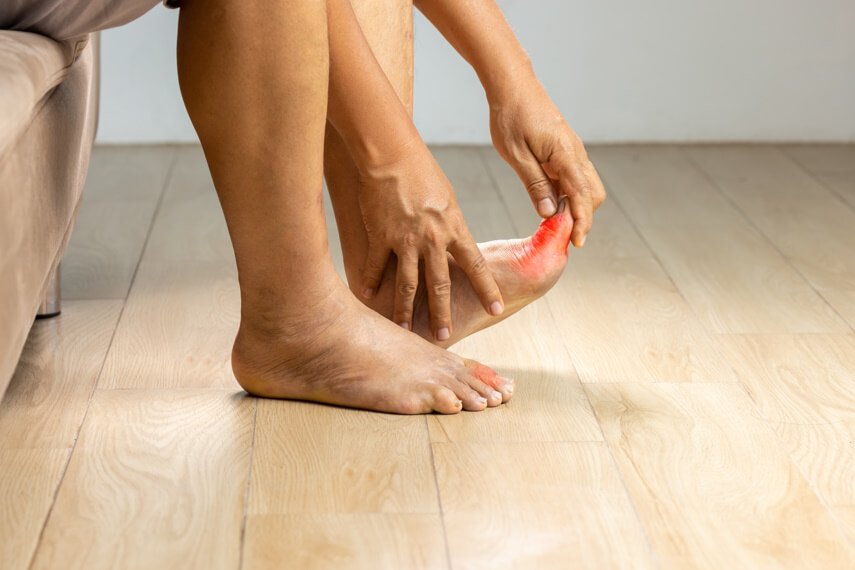25, Feb 2025
Safe Corn Removal for Diabetics: Essential Tips and Techniques for Healthy Feet
Foot health is an essential part of managing diabetes. Among the prevalent yet neglected issues of diabetic patients is corn on foot diabetes. Corns are hardened layers of skin that develop as a result of repeated friction or pressure, most often on the toes or soles. Though they may be a nuisance, for a person with diabetes, they can be dangerous.
Diabetes compromises nerve function and blood flow, and as a result, wounds cannot heal well. A minor injury, such as a cut from treating corn oneself, can turn into serious issues like corn abscesses, ulcers, or infections. Therefore, learning to treat corn on diabetic feet is vital for maintaining long-term foot health.
At Surat Diabetic Foot and Ulcer Clinic, we are experts in delivering quality foot care to diabetic patients, making sure that diabetes corn on foot is treated professionally and safely. In this guide, we will take you through the dangers, safe removal, and preventive care to maintain your feet healthy and pain-free.
Understanding Foot Corns and Diabetes
A corn is a thickened patch of skin that develops from constant pressure or rubbing. It may occur on weight-bearing parts of the foot, including the toes, heel, or ball of the foot. In non-diabetics, corns are an annoyance, but in those with foot corn and diabetes, they are a concern.
Diabetes affects foot health in two major ways:
1. Neuropathy (Nerve Damage):
- As time passes, high blood glucose may damage nerves (diabetic neuropathy), resulting in numbness in the feet.
- It becomes hard to notice pain or pressure, and the risk of undetected wounds or infections grows.
2. Poor Circulation:
- Diabetes may limit blood supply, reducing healing times.
- Even small injuries, such as cuts or scrapes from trying corn treatment for diabetic patients at home, may form severe infections or ulcers.
Ignoring corns can lead to complications such as corns and diabetic foot infections, making it essential to take proper care and seek professional help when needed.
Risks of Self-Treatment for Diabetic Patients
Many people try to remove corn at home using sharp objects, medicated pads, or over-the-counter treatments. However, for diabetic individuals, this can be extremely dangerous. Here’s why:
- Risk of Infection: Diabetic skin is more susceptible to infections, and a minor cut or scrape can lead to a severe infection or ulcer.
- Slow Healing: Due to poor circulation, even a small wound from using a razor blade or a corn remover tool may take longer to heal, increasing the risk of further complications.
- Potential for Severe Foot Problems: If an infection spreads, it may result in foot ulcers, gangrene, or even amputation in extreme cases.
At Surat Diabetic Foot and Ulcer Clinic, we strongly advise against self-treatment. Instead, let a professional podiatrist or foot care specialist safely manage your corn and diabetic foot concerns.
Safe Corn Removal Techniques
To avoid complications, diabetic individuals should opt for safe and medically approved methods for how to remove a corn from a diabetic foot. The best approach is professional care. Here’s how experts handle it:
- Gentle Debridement: A podiatrist carefully removes the hardened skin using sterilised tools, ensuring no harm to the underlying skin.
- Customised Orthotics: If the corn is caused by pressure points in footwear, custom-made orthotic inserts can help redistribute pressure and prevent corns from forming again.
- Padding and Taping: Specialised padding techniques can reduce pressure on the corn, allowing it to heal naturally.
If you notice persistent pain, redness, or signs of infection, consult Surat Diabetic Foot and Ulcer Clinic for expert diabetic foot corn treatment immediately.
At-home Care Tips to Prevent Corns
Preventing corns is easier than treating them. Follow these simple at-home care tips to keep your feet healthy:
Wear Proper Footwear:
- Choose well-fitted shoes with enough room for your toes.
- Avoid tight, pointed shoes that cause pressure points.
Moisturize Daily:
- Dry skin can lead to cracks and corns. Apply a diabetes-friendly moisturizer, but avoid putting it between your toes to prevent fungal infections.
Inspect Your Feet Daily:
- Look for any signs of redness, irritation, or developing corns.
- If you have trouble seeing your feet, use a mirror or ask for help.
Use Protective Padding:
- Non-medicated pads or soft cushioning can help relieve pressure on high-friction areas.
Trim Nails Carefully:
- Long toenails can alter foot mechanics, increasing pressure on certain areas, which may lead to corns.
By incorporating these simple yet effective tips, you can minimise the chances of developing foot corns and diabetes and maintain overall foot health.
When to Seek Professional Help
If you notice a corn on your foot and have diabetes, it’s best to consult a specialist rather than trying to remove it yourself. Seek professional help if you experience:
- Persistent Pain or Inflammation: If the corn becomes red, swollen, or painful, it may indicate an infection.
- Changes in Skin Colour or Texture: If the skin around the corn turns dark or bluish, it could be a sign of poor circulation.
- Signs of Infection: If you notice pus, warmth, or a foul smell, it’s crucial to get medical attention immediately.
At Surat Diabetic Foot and Ulcer Clinic, we provide expert foot care solutions for diabetic individuals, ensuring safe and effective treatment for corns and other foot-related concerns.
Conclusion
Corns can be thought of as minor, but to people with diabetes with corns on their feet, they are capable of causing severe complications when not managed suitably. The secret to good foot health is prevention, wearing the right footwear, and accessing professional care promptly.
Do not try to self-treat, avoid corn pads for diabetics, and use medical help always when handling foot corn and diabetes. If you or someone near you is having issues with corns or other problems in the feet, contact Surat Diabetic Foot and Ulcer Clinic today. Our experts are committed to providing excellent, specialised service to ensure you have healthy feet as well as general health.
FAQs
Why is corn removal risky for diabetics?
Diabetic individuals often have reduced sensation in their feet due to neuropathy, making it difficult to detect injuries. Attempting to remove corn at home can lead to cuts or infections, which may not heal properly and can escalate into serious complications.
What are the safest ways to remove foot corns for diabetics?
The safest approach is to seek professional care. Podiatrists or foot care specialists can assess the condition and perform gentle debridement or surgical excision if necessary, using sterilised instruments to minimise the risk of infection.
Can diabetics use corn pads or medicated plasters?
It's advisable for diabetics to avoid over-the-counter corn pads or medicated plasters containing salicylic acid, as they can cause skin irritation or burns. Consulting a healthcare professional for appropriate treatment is recommended.
How can diabetics prevent foot corns from forming?
Preventive measures include wearing well-fitting shoes, keeping feet clean and dry, moisturising regularly, inspecting feet daily for any changes, and using non-medicated protective pads to cushion.
How to treat corn on diabetic feet safely?
The safest way to treat corn on diabetic feet is to seek professional care from a podiatrist. Avoid using over-the-counter corn removers or sharp tools, as they can cause injuries and infections. Instead, a specialist may gently trim the corn, recommend custom orthotics, or suggest padding to reduce pressure. Keeping your feet moisturised, wearing well-fitted shoes, and inspecting your feet daily can help prevent complications.

.webp)





.jpg)

